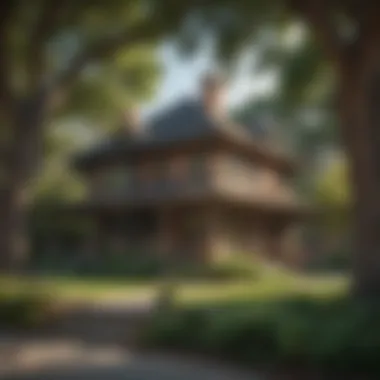Unveiling the Essence of Kingman Park, DC Neighborhood


Intro
Kingman Park is a neighborhood that encapsulates the vibrant spirit of Washington, D.C. This area holds a significant place in the city’s landscape, intermingling history with modern residential life. Understanding Kingman Park involves exploring its past, present, and how it stands poised for future growth. This neighborhood is more than a simple residential area; it reflects the dynamics of community, culture, and architecture that make D.C. unique.
One of the key aspects of Kingman Park is its historical significance. Established in the early 20th century, the neighborhood showcases a variety of architectural styles that tell stories of different eras. This article will delve into notable homes and locations within Kingman Park, revealing their beauty and charm.
Additionally, insights into community dynamics will shed light on the residents, their activities, and how they shape the neighborhood. By emphasizing local amenities alongside potential areas for development, readers can appreciate the ongoing evolution of Kingman Park.
Ultimately, this exploration serves not only real estate enthusiasts but also urban planners and anyone with an interest in urban development. The inclusion of community programs and local governance will offer a rounded perspective on how Kingman Park continues to be a captivating part of Washington, D.C.
Featured Homes and Locations
Kingman Park features an assortment of homes that reflect its diverse history. The architecture varies from quaint bungalows to more expansive single-family homes. Each building tells a story about the neighborhood's past and many of them are well-preserved, adding character to the area.
Showcase of Unique Homes
Some notable styles include:
- Craftsman Bungalows: These homes exhibit overhanging eaves and exposed rafters. They are often surrounded by colorful gardens.
- Colonial Revival Cottages: Known for their symmetry and rectangular shapes, they embody traditional American architectural ideals.
- Contemporary Designs: New constructions are emerging, showcasing modern architectural practices and eco-friendly materials.
Each home has its own allure and contributes to the overall neighborhood aesthetic. Owners take pride in their properties, enhancing the streets with seasonal decorations and community engagement.
Iconic Locations Within Kingman Park
Beyond residential homes, there are several iconic locations to explore:
- Kingman and Heritage Islands Park: This park offers natural beauty and recreational opportunities for residents.
- The District of Columbia’s Historic Resources: Several sites here are listed in the National Register of Historic Places, reflecting the area’s rich past.
- Local Community Centers: These sites provide vital community services and programs, fostering engagement and connection among residents.
"Kingman Park is a testament to the resilience and adaptability of urban communities, blending the old with the new as it evolves over time."
Design Inspiration
The design fabric of Kingman Park provides a wealth of inspiration. Various interior and exterior elements come together to form a cohesive yet diverse design palette. By analyzing current trends and the influences of the neighborhood, design enthusiasts can draw valuable insights.
Interior Design Trends
In Kingman Park, the interior design often emphasizes:
- Open Floor Plans: Many homes favor a flow that blends living room, dining room, and kitchen.
- Natural Materials: Wood and stone are prominent, connecting interiors with the outside landscape.
- Eclectic Styles: Homeowners mix different styles, creating personal environments that reflect individuality.
Outdoor Spaces and Landscaping
Landscaping in Kingman Park often reflects the simplicity and functionality of outdoor spaces. Trends include:
- Native Plantings: Residents focus on using plants that thrive in the local climate, promoting sustainability.
- Relaxation Zones: Patios and gardens serve as retreats for families and friends to gather.
Landscapes in this area enhance not just the homes, but the overall community appeal, making Kingman Park a delightful place to live and enjoy life.
In summary, Kingman Park stands as a microcosm of urban life in D.C., combining historical perspectives with contemporary living and community bonds. Each aspect, from unique homes to vibrant public spaces, reflects a deep commitment to preserving the past while embracing the future.
Intro to Kingman Park
Kingman Park holds a distinct place in Washington, D.C.'s urban tapestry. This neighborhood is not just a locale; it serves as a reflection of the diverse community and historical evolution that characterizes the capital. In this article, we aim to delve into what makes Kingman Park a unique area worth exploring.


Understanding Kingman Park involves looking at several factors. First, the geographical setting provides a backdrop that shapes its identity. Additionally, the historical context reveals the events and changes that have molded the neighborhood over time.
There are numerous benefits to examining this area. For real estate enthusiasts, insights into property values and community life can guide investment decisions. Travel lovers may find that the parks and architecture offer leisurely visits and rich cultural experiences. Interior design aficionados can appreciate the diverse architectural styles present. Overall, exploring Kingman Park is insightful for anyone interested in urban life in D.C.
Geographical Overview
Kingman Park is situated in the Northeast quadrant of Washington, D.C. This specific location offers convenient access to various major roadways and public transport systems. The neighborhood is bounded by Benning Road to the south and Harry Thomas Way to the east, ensuring connectivity to other parts of the district. Furthermore, its proximity to the Anacostia River features prominently in its geographical narrative.
The layout of the neighborhood includes residential areas, parks, and recreational facilities, which are integral to community life. Streets are lined with trees, contributing to a suburban ambiance while still being near the bustling urban core. The park itself is a considerable green space that encourages outdoor activities, which enriches the geographical character of Kingman Park.
Historical Background
Kingman Park's history is intertwined with broader historical trends in Washington, D.C. Established in the early 20th century, the area underwent significant development during the post-World War II era, transforming from farmland to a vibrant neighborhood. Housing patterns shifted dramatically as returning veterans sought affordable living spaces, leading to increased construction in Kingman Park.
Over time, the area has faced several challenges and opportunities. Moreover, numerous community initiatives have aimed to preserve the neighborhood's character while adapting to modern demands. Local organizations have played vital roles in advocating for community interests, demonstrating how historical narratives are linked to current realities. Understanding this historical background enriches our appreciation of Kingman Park today.
Significant Landmarks in Kingman Park
The concept of significant landmarks extends beyond mere physical structures; it encompasses elements that shape the narrative of a community. In Kingman Park, landmarks serve as focal points for social interactions and cultural experiences. They also underscore the identity of the neighborhood within the broader context of Washington, D.C. This section delineates two vital aspects of Kingman Park: its parks and recreational areas, and its architectural highlights.
Parks and Recreational Areas
Parks in Kingman Park play a crucial role in enhancing the quality of life for its residents. These green spaces are not just areas for leisure but are instrumental in fostering community spirit. Kingman Park itself features a well-maintained public park, ideal for activities such as jogging, picnicking, and casual gatherings. The park also includes children's play areas, which cater to families and promote outdoor activities among youth.
In addition, the local community often hosts events and programs in these parks, establishing them as venues for social engagement. This transforms the parks into vital community hubs, where people can meet, interact, and take part in organized activities. The presence of greenery also contributes to the overall aesthetic appeal of the neighborhood, providing a natural contrast to its urban environment.
Furthermore, recreational amenities like walking paths, sport courts, and dog parks enhance the usability of these spaces. Kingman Park manages to strike a balance between providing essential recreational facilities and preserving an inviting atmosphere for residents and visitors alike. The significance of these parks is evident not only in their physical presence but also in how they enrich community ties and promote healthy lifestyles.
Architectural Highlights
The architectural features in Kingman Park reflect a mix of styles that embody the evolution of the area. As with many neighborhoods in Washington, D.C., mid-20th-century homes are prominent in Kingman Park, particularly brick bungalows and single-family homes. These structures are appreciated for their durability and classic charm. Many homes showcase meticulous landscaping, enhancing the livability and overall appeal of the area.
Among the highlights is the architecture of specific notable buildings that stand out due to their unique designs and historical significance. The aesthetics of these structures contribute to the visual identity of Kingman Park and offer insights into the area's development over time. Some homes have retained original features, adding to their historical value, while others have undergone renovations, blending modernity with tradition.
Furthermore, community-driven design initiatives have begun to emerge, where residents take an active role in shaping the physical environment. This involvement fosters a sense of pride and ownership, ensuring that architectural transformations respect the neighborhood's character.
In summary, significant landmarks in Kingman Park provide functional and aesthetic contributions to the neighborhood. Parks offer vital recreational spaces that cultivate community relationships, while the architectural elements reflect both the history and evolution of the area. Understanding these facets is essential for anyone interested in the fabric of Kingman Park, whether they are potential homeowners, urban planners, or simply those with a passion for real estate.
Demographics and Community Life
Understanding the demographics and community life of Kingman Park is essential for grasping the essence of this vibrant area. The neighborhood is home to a diverse population, which brings different perspectives and experiences, enriching the community's fabric. This aspect of Kingman Park plays a crucial role in shaping local culture, social dynamics, and economic development. It is important to both residents and potential newcomers inspecting the neighborhood for its livability and community engagement endeavors. A closer examination reveals the unique characteristics of its population, the depth of its cultural diversity, and the active community organizations that foster involvement.
Population Overview
Kingman Park has seen fluctuations in its population over the years. As of the latest census, approximately 5,000 residents call this neighborhood home. The population is mostly composed of young families and professionals, illustrating a trend towards revitalization in the area. The demographics include people from various age groups, although a significant proportion are millennials and young professionals.
Several factors contribute to this growing population. Accessibility to public transportation and recreational areas makes Kingman Park an appealing choice. The neighborhood also boasts a sense of community that encourages social interaction and connection among residents.
Cultural Diversity
Cultural diversity is one of the cornerstones of Kingman Park. The residents hail from various ethnic backgrounds, which contributes to a melting pot atmosphere. This diversity leads to a rich cultural exchange and a variety of community events, involving music, art, and food that reflect the myriad backgrounds of the residents.
The presence of cultural festivals, local markets, and art shows showcases this diversity. Residents appreciate and celebrate their differences, often finding common ground through shared community values and experiences. Local organizations bridge the gap between cultures and facilitate connections among residents. This cultural richness adds depth and vibrancy to everyday life in Kingman Park.


Community Organizations and Engagement
Community engagement in Kingman Park is facilitated by various organizations that aim to strengthen ties among residents. Organizations like the Kingman Park Civic Association play a pivotal role in addressing local issues and advocating for improvement projects. These groups organize neighborhood clean-ups, vocal forums for discussing relevant matters, and cultural events that celebrate the community’s diversity.
Moreover, neighborhoods’ engagement initiatives encourage residents to take part in local governance and planning. This involvement leads to a more vibrant and cohesive community. Through volunteering opportunities and collaborative projects, residents actively shape their neighborhood, contributing to a sense of pride and ownership.
Local Amenities and Services
Local amenities and services play a crucial role in shaping the quality of life in any community, including Kingman Park. They provide residents with essential resources and conveniences that contribute to a vibrant neighborhood atmosphere. In Kingman Park, the variety and accessibility of these amenities significantly influence resident satisfaction and overall community engagement. This section will delve into the key components of local amenities, showcasing the diverse options available to residents of Kingman Park.
Schools and Educational Institutions
Education is a core element of community life. In Kingman Park, several schools and educational institutions serve the needs of families in the area. Schools such as Philip's Academy Public Charter School and Calvary Christian Academy provide foundational education for children of various age groups. The presence of these institutions not only enhances the community's appeal to families but also fosters a sense of unity among residents.
Parents often prioritize local schools when deciding where to reside. Good schools increase property values, attract families, and promote community involvement. Beyond traditional K-12 education, Kingman Park is also near several higher education institutions, which enrich the local culture and economy. Access to educational resources can also include libraries and community learning centers, contributing to a well-rounded educational experience.
Health and Wellness Facilities
Health and wellness are closely tied to the overall satisfaction of community members. Kingman Park is conveniently located near various medical centers and wellness facilities. These include Union Market Health and several local clinics. These healthcare options provide essential services for residents, from routine checkups to specialized care.
Wellness facilities, such as gyms and community fitness programs, can also be found throughout the area. The presence of such amenities promotes a healthy lifestyle, encouraging physical activity and community engagement. Access to quality healthcare can be a deciding factor for many families when choosing a neighborhood, further solidifying Kingman Park’s position as a desirable place to live.
Shopping and Dining Options
Shopping and dining are integral facets of community life. Kingman Park boasts an array of options that cater to various preferences and needs. The Kingman Park Shopping Center offers a mix of local and chain stores, providing residents with convenient access to groceries, clothing, and other essentials.
Dining options in the area are equally diverse. Restaurants such as The Coffee Bar and Capitol City Brewing Company serve not only to satiate appetites but also to bring people together. These venues provide opportunities for social interaction and community building. The availability of diverse culinary experiences adds to Kingman Park's charm, attracting both residents and visitors.
"The presence of local businesses and dining establishments is significant for building community rapport and loyalty."
In summary, the local amenities and services in Kingman Park are vital to its overall character. They enhance the neighborhood’s livability by providing essential resources for education, health, and daily conveniences. As Kingman Park continues to develop, maintaining these services will be crucial in meeting the needs of its residents.
Transportation and Accessibility
Transportation plays a crucial role in the overall livability and appeal of Kingman Park. Accessibility is vital for residents and visitors alike, impacting social interactions, economic opportunities, and daily convenience. A well-connected community enhances its attractiveness, especially in a city like Washington D.C., where mobility influences the quality of life. In this section, we will delve into the public transportation system and road connectivity that define Kingman Park’s accessibility.
Public Transportation System
Kingman Park is serviced remarkably well by the local public transportation network. The Washington Metropolitan Area Transit Authority (WMATA) provides various bus routes that connect residents to nearby metro stations.
- Metro Bus Services: Several bus lines traverse Kingman Park, making stops at central points. This connectivity allows for easy access to other neighborhoods and the heart of the city.
- Anacostia Metro Station: The closest subway access is at the Anacostia Metro Station, situated a short bus ride away. This station is a part of the Green Line, connecting users to major hubs in D.C. and beyond, such as the historical district and business corridors.
In addition, Kingman Park benefits from an active bike-sharing program that supports alternative commuting methods. Residents can rent bikes from various docking stations scattered across the neighborhood, promoting a healthier lifestyle while decreasing reliance on motor vehicles. The community also includes bike lanes that facilitate safe cycling, contributing to a multi-modal transportation system.
Road Connectivity
The road infrastructure in Kingman Park is designed to accommodate the flow of residents and visitors. Several main roads form the navigable arteries of the neighborhood:
- East Capitol Street: This major thoroughfare runs along the southern boundary of Kingman Park, providing direct access to downtown D.C. and beyond.
- Benning Road: Forming the northern edge of the neighborhood, Benning Road offers crucial connectivity to nearby suburbs and other key residential areas.
Furthermore, local streets are well maintained and structured to promote easy navigation, which is beneficial both for residents and service vehicles. The neighborhood's layout enhances connectivity within Kingman Park, enabling quick access to local amenities.
"Efficient transportation systems not only improve quality of life but also boost local economies."


In summary, the transportation options available in Kingman Park encompass an effective public transport system and well-connected roads. These infrastructures facilitate movement within the community and create a hospitable environment for residents and visitors. This ultimately reinforces Kingman Park's appeal as a thriving urban neighborhood.
Real Estate Trends in Kingman Park
Real estate in Kingman Park is a subject of considerable interest, encapsulating not just the financial implications but also the social fabric of the community. Understanding the trends in property values and the dynamics of the local market provides crucial insights for both potential buyers and investors. Moreover, these trends also reflect the overall economic health of the area, influencing its character and appeal.
Property Values and Market Dynamics
The real estate market in Kingman Park presents an attractive proposition for homeowners and investors alike. Over the past few years, property values in the area have seen substantial growth.
- Increased Demand: The demand for residential properties has surged, driven by the neighborhood's accessibility to public transportation and proximity to downtown Washington, D.C.
- Price Movements: Properties have typically appreciated due to factors such as community development and infrastructure upgrades. This upward trend in property valuation indicates a healthy market, which is appealing for both sellers and buyers.
- Investment Opportunities: Real estate investors explore Kingman Park for potential rental income. The area’s ongoing enhancements and an expanding population contribute to a favorable rental market.
"The increase in investment activity in Kingman Park denotes a growing confidence in its potential as an urban residential choice."
However, buyers should also be aware of the variations in pricing based on property type and condition. Older homes may present opportunities for renovation, while newer constructions often come at a premium.
Home Styles and Architectural Trends
Kingman Park showcases a blend of architectural styles, reflecting its history and the evolving preferences of its residents. The characteristics of homes in this area offer a snapshot of its past, while also highlighting contemporary influences.
- Historic Homes: Many residences in Kingman Park retain classic designs, incorporating Victorian and Colonial-style elements. These homes are often valued for their historical significance and unique craftsmanship.
- Modern Influences: In contrast, new constructions tend to emphasize modern architectural principles, featuring open spaces and energy-efficient designs. These contemporary homes appeal to a demographic that prioritizes sustainability and convenience.
- Diverse Home Styles: The variety of home styles fosters a rich aesthetic. From single-family houses to townhomes, the diversity ensures that potential homeowners can find a residence that suits their personal taste.
The architectural landscape of Kingman Park serves not only as a visual treat but also plays a role in establishing community identity. As the area develops, maintaining its unique architectural flavor will be key to preserving its charm.
Community Challenges and Opportunities
The examination of community challenges and opportunities is crucial to understanding the dynamics of Kingman Park. This area, like many urban neighborhoods, faces its unique set of obstacles. However, these challenges also pave the way for opportunities that can enhance the quality of life for residents.
Social Issues and Initiatives
Kingman Park is not without social issues that affect its community cohesion. Issues such as affordable housing, access to quality education, and public safety often challenge residents. The struggle for affordable housing is particularly pressing. With rising property values, many families find it hard to stay in the area. Initiatives to combat this issue have emerged, including programs aimed at providing financial assistance to low-income residents.
Additionally, community organizations have taken the initiative to address educational disparities. They offer tutoring and mentorship programs focused on empowering the youth. Initiatives like neighborhood watch programs have been established in response to safety concerns, helping to foster a sense of security.
"Community engagement is vital. Initiatives that address social issues create a collaborative environment that nurtures growth and belonging."
Future Development Plans
Future development plans in Kingman Park present various opportunities to shape the neighborhood's trajectory positively. Local government and planning teams seek to enhance infrastructure while preserving the area's historical character. Projects aim to upgrade public spaces, making them more accessible and inviting.
Planned developments include new parks and recreational facilities that facilitate community gatherings and foster social interaction. Moreover, a focus on eco-friendly practices in construction is emerging as a trend. This embrace of sustainability can lead to better long-term health for the community and the environment.
Concerns remain about gentrification. It is vital for stakeholders to ensure that the existing community can thrive alongside new developments. By striking a balance between growth and preservation, Kingman Park has the potential to not only retain its charm but also evolve into a more vibrant community.
Closure
The conclusion of this article serves as a crucial wrap-up to the discussion surrounding Kingman Park. It highlights the key points examined throughout the sections, reflecting on both the unique characteristics of the neighborhood and its significance within the broader context of Washington, D.C.
Summary of Kingman Park's Appeal
Kingman Park is distinguished by its blend of historical significance and modern livability. The unique geographical setup, along with its rich historical background, positions Kingman Park as a noteworthy example of urban development. A diverse demographic makeup enriches the community's culture, making it an attractive destination for families and individuals alike.
Furthermore, the presence of parks and various architectural features enhances Kingman Park's appeal. It offers a respite from the hustle of the city while maintaining accessibility to urban amenities. Notably, local schools and health facilities provide essential services that support family life.
In summary, Kingman Park offers a vibrant residential experience, marrying convenience with community spirit. The historical layers intertwined with contemporary needs mark it as a compelling part of D.C.'s rich tapestry.
Final Thoughts on Urban Living in D.C.
Living in Washington, D.C., presents unique opportunities and challenges. Kingman Park exemplifies the potential for urban areas to simultaneously provide a sense of community and access to cultural dynamics. Urban living fosters an atmosphere rich in diversity, and Kingman Park reflects this in its population and community initiatives.
However, challenges remain, including social issues and urban development pressures. Community engagement and awareness are key to maintaining the neighborhood's unique charm and ensuring its sustainable growth. The future holds promise for Kingman Park, with potential initiatives that will shape its landscape for years to come.







